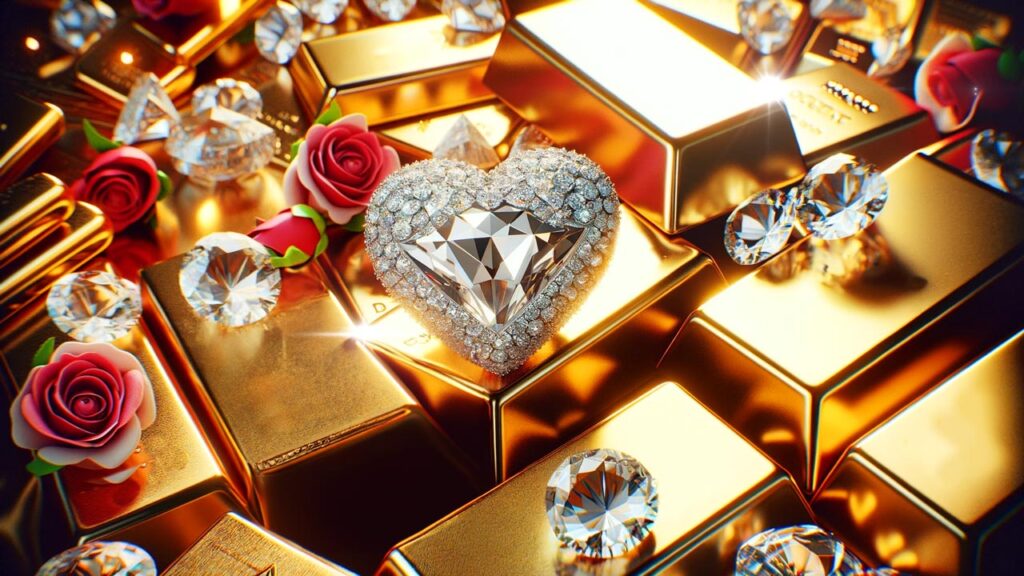The Value of Diamonds Sinks as Gold Stays Strong
Valentine’s Day is here and you might find yourself buying (or wishing you had remembered to buy) a Valentine’s Day present. A classic romantic present involves gold, diamonds, and sometimes both. And both diamonds and gold seem at first blush to have a lot in common.
Both are or at least can be beautiful. Diamonds are one of the shiniest gemstones (high refractive index if you’re science-minded) and can be perfectly clear or come in a wide range of colors. Gold is of course famously appealing to look at. Both diamonds and gold convey luxury and wealth, and both are regularly used to make luxury products such as rings, bracelets, watches, and earrings.
The expense of both diamonds and gold is one reason why it’s so common for both diamonds and gold to be part of an engagement ring- the expense of these materials makes engagement rings expensive which helps them serve as a costly sign of commitment.
Some have argued that the similarities between diamonds and gold are even greater, given that some are turning to diamonds as a store of value and as an investment. But this overlooks why gold has historically been preferred as a store of value to diamonds, and how new technological developments have made the differences between diamond and gold even greater.
First, diamonds lack the history of gold. While gold has spontaneously emerged as a treasured metal and as a store of value or as a currency from civilization to civilization, the emergence of diamonds as a valuable commodity is much more recent and historically contingent. While diamonds were always recognized as gemstones, broad-based demand for diamonds did not emerge in the West until the 1800s and their famous role as the central stone in an engagement ring did not emerge until the mid 1900’s due to savvy marketing campaigns. So demand for gold is more stable and organic than the demand for diamonds. When central banks look to preserve the value of their currency, they often increase strategic gold reserves, not strategic diamond reserves.
While diamonds and gold might be seen as similar because both have industrial uses as well as usage in jewelry and investment, that overlooks the fact almost all gold is used for jewelry or as an investment while 80% of diamonds are used by industry. While every single ounce of gold could be used in industry, jewelry, or as an investment, because gold is fungible and divisible, the opposite is true for diamonds. Diamond value varies dramatically between individual stones. The value of a diamond depends on its size, its color, its clarity, and its cut. Many diamonds are worthless for any non-industrial purposes. While gold can be used as bullion converted to jewelry then melted back into bullion, cutting a diamond over and over would destroy its value. Demand for gold is driven by every sector. Demand for small industrial diamonds is not driven by demand for large diamonds that could feature in jewelry, and vice versa.
Both gold and (gemstone quality) diamonds are valuable because of their relative rarity compared to demand. Gold is rare because the element, gold, is genuinely rare. Diamonds have been rare, because while they are made of carbon, a common element, the specific arrangement of carbon atoms that make up a diamond is rarely produced in nature, at least not in the form of large diamonds.
But advances in technology have changed that. It is now much cheaper to buy a lab-grown diamond for an engagement ring than to buy a diamond mined out of the earth. And these lab-grown diamonds are not stones that happen to resemble diamonds such as cubic zirconia, they are genuine diamonds created in a lab. Advances in technology have driven down the prices of both lab-grown and naturally mined diamonds. The value of lab-grown diamonds is down by over 70% since the start of 2016 and even natural mined diamonds have fallen by over 25%. It is unlikely that technological improvements in creating lab-grown diamonds will stop improving meaning lab-grown diamonds will be able to supply diamonds to both the industrial market and the jewelry market.
If you think diamonds are prettier than gold, I wouldn’t argue. But I know which one I would rather have as part of my investment portfolio.





 Innovation has a silent killer… a scourge that America has aided and abetted for over a century. Innovative activity is the backbone of the economy. Because of Google, Honda, and Netflix, life is easier for billions of people around the globe. A Stanford study found that up to 85% of economic growth is due to innovation. But what if all […]
Innovation has a silent killer… a scourge that America has aided and abetted for over a century. Innovative activity is the backbone of the economy. Because of Google, Honda, and Netflix, life is easier for billions of people around the globe. A Stanford study found that up to 85% of economic growth is due to innovation. But what if all […] In 2009, 140 banks failed, and a recent report from financial consulting firm Klaros Group says that hundreds of banks are at risk of going under this year. It’s being billed mostly as a danger for individuals and communities than for the broader economy, but for stressed lenders across America, a string of small bank failures could quite […]
In 2009, 140 banks failed, and a recent report from financial consulting firm Klaros Group says that hundreds of banks are at risk of going under this year. It’s being billed mostly as a danger for individuals and communities than for the broader economy, but for stressed lenders across America, a string of small bank failures could quite […] Cocoa prices have dumped since rocketing to a dramatic peak last month as an El Nino cycle winds down and traders rush out of the illiquid market. For now, depreciating fiat currencies are still keeping the cocoa price still far above its 2023 levels. Coffee has had a similar rise and subsequent correction — but now, inflation and other factors are conspiring to […]
Cocoa prices have dumped since rocketing to a dramatic peak last month as an El Nino cycle winds down and traders rush out of the illiquid market. For now, depreciating fiat currencies are still keeping the cocoa price still far above its 2023 levels. Coffee has had a similar rise and subsequent correction — but now, inflation and other factors are conspiring to […] California’s government bet that they knew better than the free market. And now millions are paying the price. The story begins in 1919, when the city of Berkley, California instituted legislation setting aside districts that would only allow the construction of single-family housing. The idea spread, and soon much of California’s urban areas had adopted the zoning policy. Today, approximately 40% of the total land in Los Angeles is […]
California’s government bet that they knew better than the free market. And now millions are paying the price. The story begins in 1919, when the city of Berkley, California instituted legislation setting aside districts that would only allow the construction of single-family housing. The idea spread, and soon much of California’s urban areas had adopted the zoning policy. Today, approximately 40% of the total land in Los Angeles is […] The yen was once known as a safe-haven currency for investors to protect themselves when broader markets are shaky or other currencies are dropping, but those days are numbered. A stable government and consistent (and low) interest rates have been some of the driving factors, but it’s the unwinding of that ultra-low interest rate policy that will be the yen’s “safe […]
The yen was once known as a safe-haven currency for investors to protect themselves when broader markets are shaky or other currencies are dropping, but those days are numbered. A stable government and consistent (and low) interest rates have been some of the driving factors, but it’s the unwinding of that ultra-low interest rate policy that will be the yen’s “safe […]